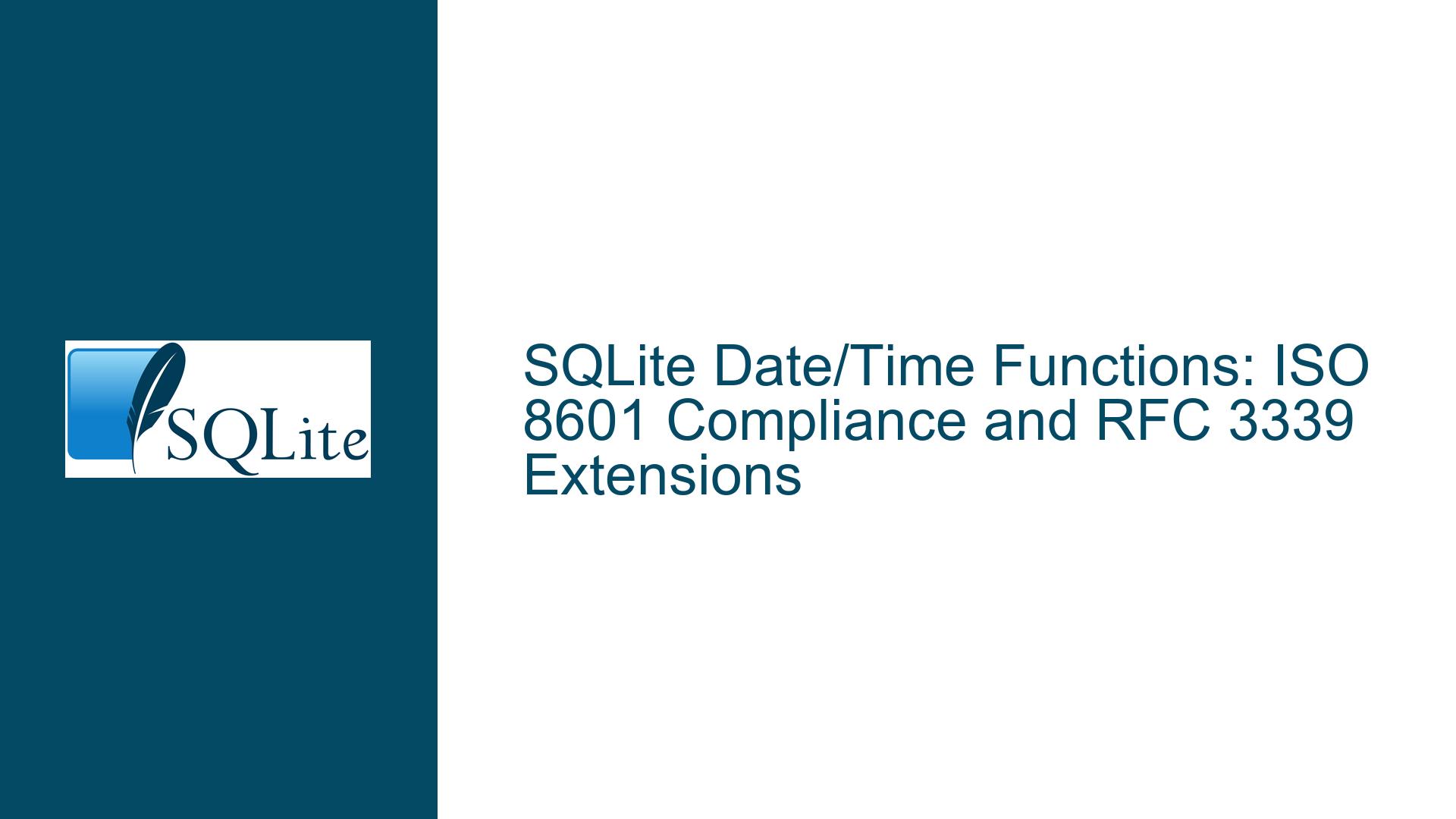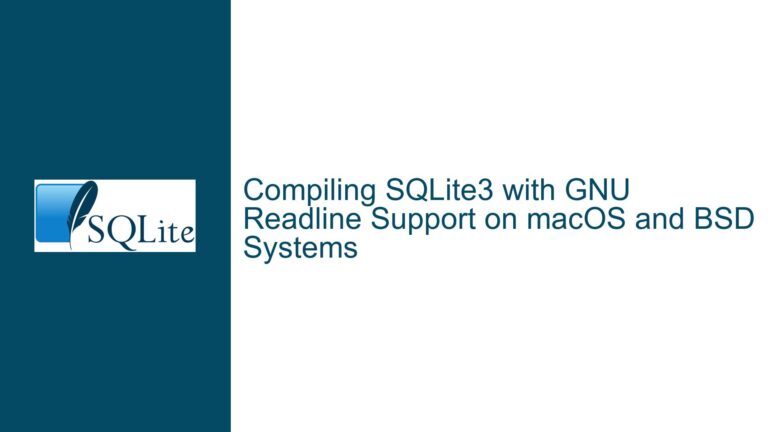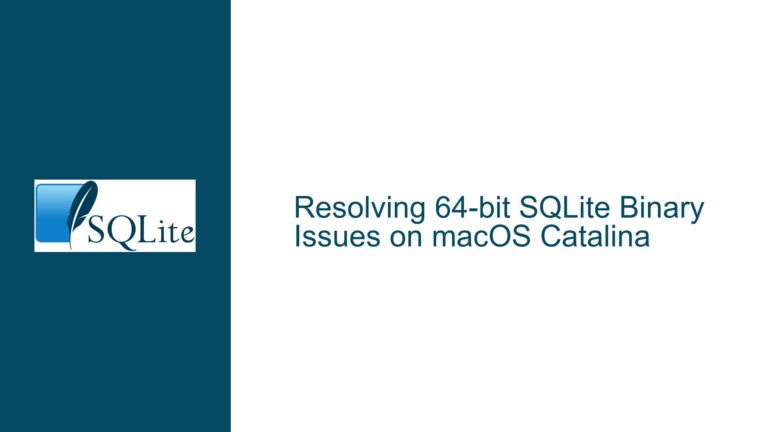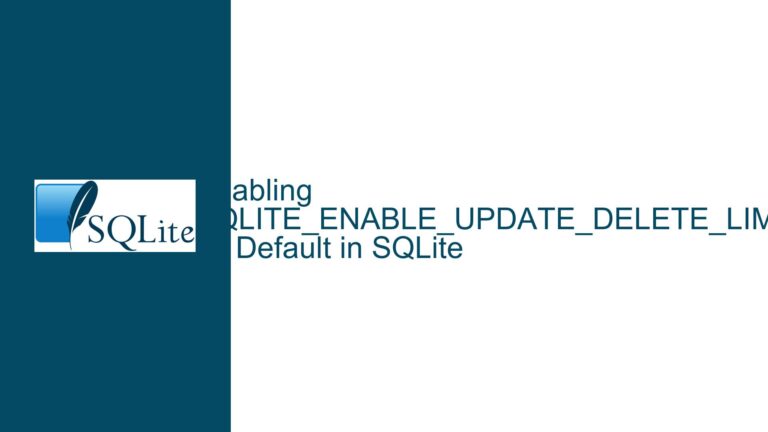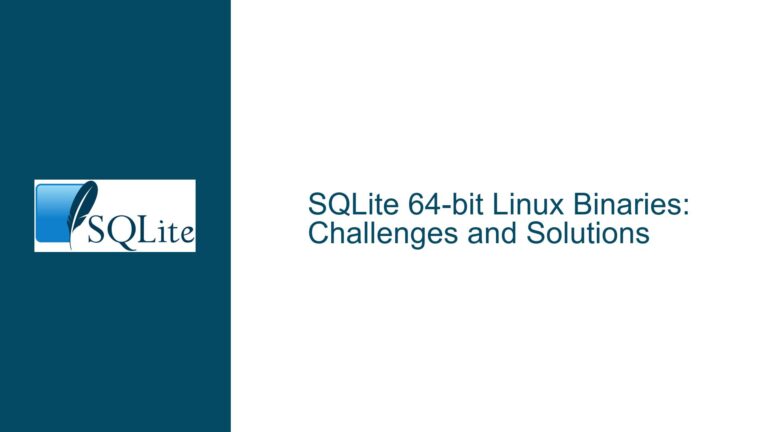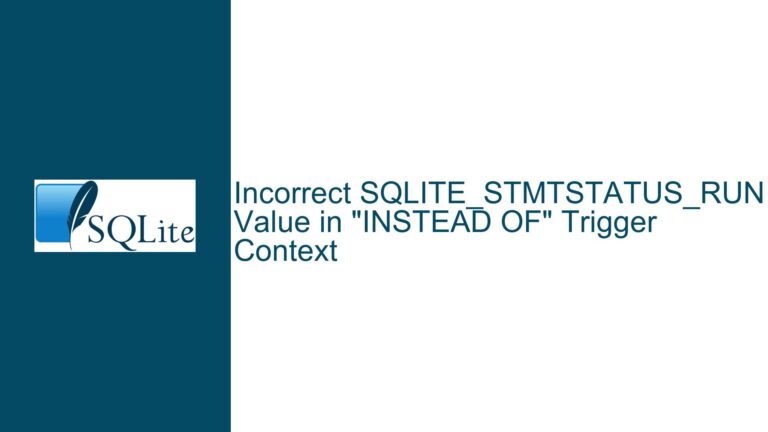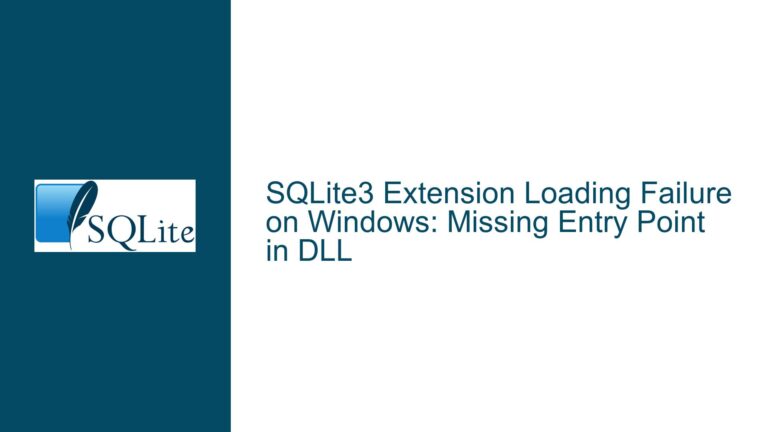SQLite Date/Time Functions: ISO 8601 Compliance and RFC 3339 Extensions
SQLite Date/Time Storage: ISO 8601 Subset and RFC 3339 Compatibility
The SQLite documentation on date and time functions states that date and time values can be stored as "text in a subset of the ISO-8601 format." However, this description is not entirely accurate due to the inclusion of a space separator between the date and time components, which is not permitted by the ISO 8601 standard. Instead, this format aligns with RFC 3339, an extension of ISO 8601 that allows for the use of a space as a separator. This discrepancy raises questions about the proper labeling of the format in the documentation and the implications for developers relying on SQLite’s date and time handling.
The ISO 8601 standard explicitly requires the use of the letter ‘T’ to separate the date and time components. For example, a compliant ISO 8601 timestamp would look like 2022-05-07T12:13:46. In contrast, RFC 3339 permits the use of a space ( ) as a separator, making 2022-05-07 12:13:46 a valid RFC 3339 timestamp. SQLite’s implementation allows for both formats, treating the ‘T’ and space interchangeably, which introduces a subtle but significant deviation from strict ISO 8601 compliance.
This flexibility in SQLite’s date and time handling can lead to confusion, particularly for developers who are unaware of the differences between ISO 8601 and RFC 3339. The documentation currently refers to the format as a "subset of ISO-8601," which is misleading because the inclusion of the space separator extends beyond the ISO 8601 specification. To avoid ambiguity, the documentation should explicitly mention both ISO 8601 and RFC 3339, clarifying that SQLite supports a hybrid format that incorporates elements of both standards.
Misalignment Between Documentation and Implementation
The SQLite documentation provides examples of date and time storage that are non-compliant with ISO 8601 but compliant with RFC 3339. For instance, the example '2018-04-02 12:13:46' uses a space separator, which is explicitly prohibited by ISO 8601 but allowed by RFC 3339. This misalignment between the documentation and the actual implementation can lead to misunderstandings, especially for developers who rely on the documentation to ensure compliance with international standards.
The issue is further compounded by the inconsistent use of the term "ISO-8601" in the documentation. The standard is officially written as "ISO 8601" with a space, but the documentation frequently uses the hyphenated form "ISO-8601." While this may seem like a minor detail, it reflects a lack of precision that could contribute to confusion among users. Consistency in terminology is essential, particularly in technical documentation, to ensure clarity and accuracy.
Additionally, the documentation does not explicitly address the implications of using a space separator versus the ‘T’ separator. While SQLite’s datetime functions treat both formats equivalently, this behavior is not immediately obvious from the documentation. Developers who are unaware of this flexibility may inadvertently introduce inconsistencies in their data, particularly when interfacing with other systems that enforce strict ISO 8601 compliance.
SQLite’s Flexible Date/Time Parsing Rules
SQLite’s datetime functions are designed to be highly flexible in parsing date and time strings. The functions do not strictly enforce either ISO 8601 or RFC 3339 but instead adopt a hybrid approach that accommodates a wide range of formats. The date component must follow the YYYY-MM-DD format, and the time component must follow the HH:MM:SS[.fffffffffffffffff] format, where the fractional seconds are optional and can include any number of digits. The timezone component, if present, must be in the format Z, +HH:MM, or -HH:MM.
The separation between the date and time components can include any number of spaces or the letter ‘T’. For example, both '2022-05-07 16:58:30.234 -06:00' and '2022-05-07TTTTTT16:58:30.234-06:00' are treated as equivalent by SQLite’s datetime functions. This flexibility allows developers to use whichever format is most convenient for their use case, but it also introduces the potential for inconsistency, particularly when working with data from multiple sources.
The datetime functions also allow for arbitrary spacing before and after the timezone component, as well as trailing spaces at the end of the string. This leniency in parsing can be beneficial in some scenarios, but it also means that developers must be cautious when comparing or sorting date and time strings. Without consistent formatting, string-based comparisons may yield unexpected results, particularly when dealing with timestamps that include timezone information.
To ensure proper sorting and comparison of date and time strings, developers should either use a consistent format across all data or define a custom collation that accounts for the specific formatting rules used in their application. For example, a collation could be defined to sort timestamps based on their Julian Day Number, which would provide a consistent ordering regardless of the specific text representation.
Recommendations for Documentation Updates
To address the issues identified in the SQLite documentation, the following updates are recommended:
Clarify the Supported Formats: The documentation should explicitly state that SQLite supports a hybrid format that incorporates elements of both ISO 8601 and RFC 3339. This would help developers understand the flexibility of SQLite’s datetime functions and avoid confusion when working with other systems that enforce stricter standards.
Update Examples to Reflect Best Practices: The examples provided in the documentation should be updated to reflect best practices for date and time storage. For instance, the example
'2018-04-02 12:13:46'could be replaced with'2018-04-02T12:13:46'to align with ISO 8601 compliance. Alternatively, the documentation could include both formats and explain the differences between them.Standardize Terminology: The documentation should consistently use the term "ISO 8601" without a hyphen to align with the official standard. This would improve clarity and reduce the potential for confusion among users.
Provide Guidance on Sorting and Comparison: The documentation should include guidance on how to properly sort and compare date and time strings, particularly when dealing with timestamps that include timezone information. This could include examples of custom collations and best practices for ensuring consistent ordering.
By implementing these updates, the SQLite documentation would provide a more accurate and comprehensive guide to date and time handling, helping developers avoid common pitfalls and ensuring compatibility with other systems.
Practical Implications for Developers
The flexibility of SQLite’s datetime functions can be both a blessing and a curse for developers. On one hand, it allows for a wide range of date and time formats, making it easier to work with data from diverse sources. On the other hand, this flexibility can lead to inconsistencies and unexpected behavior, particularly when dealing with timestamps that include timezone information or fractional seconds.
Developers should be aware of the following practical implications when working with SQLite’s datetime functions:
Consistency is Key: To avoid issues with sorting and comparison, developers should adopt a consistent format for all date and time strings in their application. This includes using the same separator (either space or ‘T’) and ensuring that all timestamps include the same level of precision (e.g., including or excluding fractional seconds).
Timezones Matter: When working with timestamps that include timezone information, developers should ensure that all timestamps are normalized to the same timezone before performing comparisons or sorting. This can be achieved by converting all timestamps to UTC or another common timezone.
Custom Collations May Be Necessary: In some cases, developers may need to define custom collations to ensure proper sorting of date and time strings. For example, a collation could be defined to sort timestamps based on their Julian Day Number, which would provide a consistent ordering regardless of the specific text representation.
Testing is Essential: Given the potential for inconsistencies, developers should thoroughly test their date and time handling code to ensure that it behaves as expected under all scenarios. This includes testing with a variety of date and time formats, as well as edge cases such as timestamps with fractional seconds or timezone information.
By keeping these practical implications in mind, developers can leverage the flexibility of SQLite’s datetime functions while avoiding common pitfalls and ensuring the accuracy and reliability of their applications.
Conclusion
SQLite’s date and time handling is a powerful feature that provides developers with a great deal of flexibility. However, this flexibility comes with some caveats, particularly when it comes to compliance with international standards like ISO 8601 and RFC 3339. The current documentation could be improved to better reflect the nuances of SQLite’s datetime functions and provide clearer guidance for developers.
By updating the documentation to clarify the supported formats, standardize terminology, and provide guidance on best practices, the SQLite project can help developers avoid common pitfalls and ensure the accuracy and reliability of their applications. Additionally, developers should be mindful of the practical implications of SQLite’s datetime functions, particularly when it comes to consistency, timezones, and sorting.
With these considerations in mind, SQLite remains a robust and versatile tool for managing date and time data, and with a few adjustments to the documentation, it can become even more user-friendly and reliable for developers around the world.
